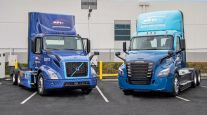Senior Reporter
CARB Approves Amendments to Onboard Diagnostic System Regulations

[Stay on top of transportation news: Get TTNews in your inbox.]
California Air Resources Board members have unanimously approved amendments to light-, medium- and heavy-truck onboard diagnostic system regulations that will require more data to be stored by the OBD systems, and address issues regarding several malfunction monitors.
The plan will update the standardization requirements for OBD systems to address limitations in the number of fault codes that can be defined and to improve other aspects of the real-time diagnostic information.
The upgrades will be an essential inspection tool for CARB’s annual smog check and heavy-duty truck inspection and maintenance program, expected to be approved by the board as soon as December.
Board considers amendments to on-board diagnostic (OBD) system regs requiring ⬆ data stored by OBD benefiting vehicle owners - ensuring malfunctions are promptly repaired, ⬇ excess emissions & ⬆ performance
▶ https://t.co/qWTzdyBVQ0
https://t.co/seOhm2kNWZ #airquality pic.twitter.com/euXkNqoKlo — CARB (@AirResources) July 22, 2021
The smog test regulation will for the first time require carriers operating but not domiciled in California to submit certified smog tests before entering the state. On the positive side, the proposed regulation would extend timelines for carriers with three or fewer trucks who are not compliant, with extra time to repair their trucks.
CARB is holding a final public workshop, via Zoom on Aug. 3, to review updated regulatory language and discuss pilot program activities for the proposed Heavy-Duty Inspection and Maintenance program. The workshop will provide an opportunity for stakeholder feedback ahead of the formal rulemaking process, which is scheduled to begin in October with an adoption hearing slated for early December.

Tunnell
“The CARB workshop will be the last opportunity to give input before it’s formally proposed in October,” said Mike Tunnell, American Trucking Associations’ California-based environmental researcher. “They’re looking at using the OBD data as the evidence that your truck doesn’t have the malfunction indicator lamp on for any fault codes. That data would get sent to CARB to confirm that the truck is operating without any mechanical issues related to its emissions control system.”
ATA said that fleets that travel in California should pay attention to the emerging smog check program that likely will result in new state operating requirements beginning in 2023.
“California light- and medium-duty vehicles are required to meet very stringent emissions standards,” said Chairman Liane Randolph at the board’s July 22 meeting. “The emissions standards for heavy-duty engines have also become significantly more stringent.”
The board’s new action is intended to ensure that vehicles and engines meet the standards in use and remain clean for their entire life, Randolph said.
The updated onboard diagnostics standard calls for warning lights to go off when emissions problems are detected so drivers can seek service to repair any problems. The diagnostics detect the malfunctions prior to tailpipe emissions exceeding limits.

Corey
The last update to the onboard diagnostics standard was in 2018, said Richard Corey, CARB’s executive officer.
“Since then, the agency’s staff has identified several changes that are needed to improve the effectiveness of the regulation, as well as its implementation,” Corey said.
The upgrades will not require new scan tools for mechanics or shops, but will be implemented via a software update to existing hardware, CARB said. They will be required as soon as model year 2025 vehicles, with early implementation for 2023 model year, said Yong Yu, a staff air pollution specialist.
“OBDs have been incorporated in heavy-duty trucks since 2013,” ATA’s Tunnell said. “It’s already part of the manufacturing process, and the requirements applying to them.”
In comments to the board at its July 22 meeting, Tia Sutton, vice president of the Truck and Engine Manufacturers Association, asked CARB to “take note of the multiple pending and overlapping programs, especially in cases where regulatory changes to one program would create conflicting or duplicative regulatory requirements with another program, as will be the case here.”
The board should consider the burden, including compounding costs, that the multiple regulations will increasingly impose on the regulated industry.
Tia Sutton, vice president of the Truck and Engine Manufacturers Association
Sutton added, “Care also needs to be taken to ensure that any changes to the OBD provisions that are contained in any of those other regulations are clearly stated, or, at minimum, clearly referenced, in the relevant OBD regulations. Further, the board should consider the burden, including compounding costs, that the multiple regulations will increasingly impose on the regulated industry.”
Want more news? Listen to today's daily briefing below or go here for more info:





